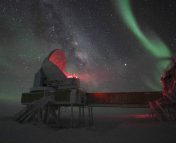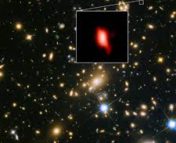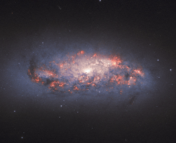Title: Illuminating the dark side of cosmic star formation two billion years after the Big Bang
Authors: M. Talia, A. Cimatti, M. Giuletti, G. Zamorani, M. Bethermin, A. Faisst, O. Le Fevre, and V. Smolcic
First Author’s Institution: University of Bologna & INAF
Status: Accepted to The Astrophysical Journal, Open access on arXiv
The modern terminology of galaxies is extraordinarily anthropomorphic; blue, star-forming galaxies are ‘alive’, and red galaxies that have ceased star-formation are ‘dead’. So then how do galaxies ‘live’? In other words, why do some galaxies form lots of stars while others do not? Are the dead galaxies older, or do they simply mature faster? What role do external forces such as galaxy mergers play in the lives of galaxies? How can their internal structures (bars, arms, and bulges) or internal forces (supernovae and active supermassive black holes) work to enhance or inhibit star-formation? These details have been the focus of the past two decades of galaxy studies, trying to answer the question: how and when did galaxies assemble their mass of stars?
The highest-level diagnostic we can construct to help us understand the ‘big picture’ of star-formation in galaxies is the Cosmic Star-formation Rate Density (SFRD) diagram. It maps the average rate at which stars are formed in the universe at a given time, per unit volume. The physics then is a matter of both supply and efficiency. How much gas is available to be formed into stars (supply) and how well did galaxies turn that gas into stars (efficiency). Constructing the SFRD diagram can then help us to understand the interplay between gas and the processes which can act to enhance or inhibit star-formation.
Although one can measure the rate of star-formation in a given galaxy, and then extend that study to perhaps a hundred or even a million galaxies, one will never be able to count the number of stars forming in every galaxy at every point in the history of the universe. Such a census will be technologically impossible far into the future since our own Milky Way galaxy obscures the light from more distant galaxies one would need to measure. Despite these challenges, astronomers have found clever means of estimating the SFRD for ~75% of the history of our Universe by carefully constructing unbiased, representative samples of galaxies such that specific inferences of that sample also hold for the general, wider population of galaxies. As shown in Figure 1, the SFRD rises for the first 3 billion years before peaking at redshift (z)~2, after which it declines for the remaining 10 billion years until today.
Observing star formation rates during the first 2 billion years of the universe (z>3) is incredibly difficult. Not only were the first galaxies intrinsically smaller and fainter than galaxies we see today, but starting at z~6, the universe is pervaded by a dense fog of neutral hydrogen (from which galaxies formed!) that obscures their light. Given these difficulties, these incredibly early galaxies are only now being observed in large numbers.
The authors of today’s paper point out that the existing samples of z>3 galaxies are not at all representative. For the most part, and almost exclusively at z>6, these galaxies are found by their bright ultraviolet emission, which has been redshifted so that it is observed in the optical and infrared. Not only must these galaxies be incredibly bright to be found at such distances, but their intensive UV emission translates directly to an enormous star-formation rate. That is, the feature that makes them easy to find also makes their star formation rates high. This is a huge bias in our samples! To overcome this bias, the authors turn to radio wavelengths. They used a large radio survey VLA-COSMOS to find 197 radio sources that have no counterpart in near-infrared wavelengths. These, they argue, are heavily dust-obscured galaxies without any UV emission — the missing link.
are also shown. Taken from Figure 1 of the paper.
Their first test was to stack the broad-band brightness measurements of each galaxy together so that they can predict what the average total spectrum would look like for these galaxies, and hence their average properties. The lack of blue light on the left-hand side of the spectrum indicates that there is no luminous UV component as seen in the UV-bright galaxies of previous samples. Moreso, they estimate an incredibly high dust extinction of a whopping 4.2 magnitudes (nearly a factor of 50)! These galaxies are super dusty indeed.
Similar to the stacked analysis, they estimate redshift and star-formation rate for each of the 98 galaxies for which they could reliably measure an infrared brightness. Owing to their radio selection not used by previous studies, they find a large sample of very high redshift galaxies at z>4.5. They estimate the redshifts and star-formation rates for the remaining 99 sources as well, but with much greater uncertainty.
Lastly, they compute the SFRD using their sample, taking care to correct for any dusty galaxies they may have missed. This is a typically dubious correction, and the authors do so by adopting an agnostic approach, seeing how their SFRD looks depending on how complete their sample might be.
As shown by the red bars in Figure 1, it is precisely this population of highly dust-obscured galaxies at z>3, invisible to optical and infrared surveys, which may indeed constitute a significant portion of the star-formation rate density in the early universe compared to other less-dusty samples!
These findings highlight the surprising extent of our ‘missing knowledge’ of the first galaxies and encourage investment in future radio surveys with ALMA and follow-up with JWST.
Edited by William Saunders with Lukas Zalesky
Cover photo: NRAO/AUI




